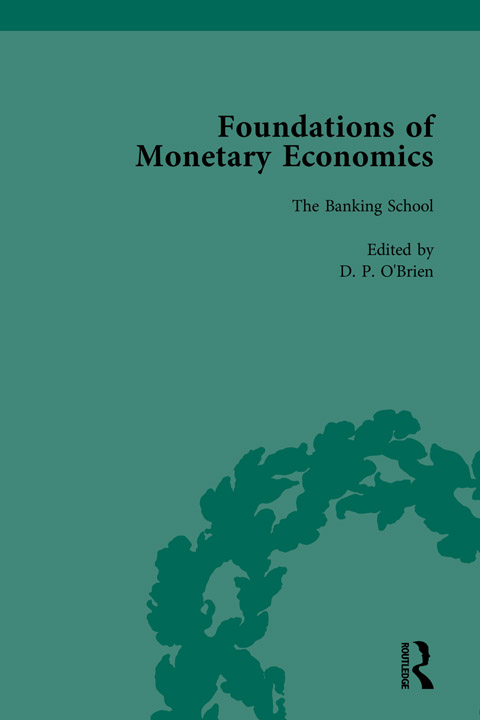Access to the full content is only available to members of institutions that have purchased access. If you belong to such an institution, please log in or find out more about how to order.
Loading content
We were unable to load the content

Foundations of Monetary Economics
- Edited by
- D. P. O’Brien
- Published: 2016
- DOI: 10.4324/9781851961900
- Set ISBN: 9781851961900
Set Contents
The extracts in this volume, all of which date from the eighteenth century, represent two important aspects of the development of monetary economics. Firstly, and most importantly, they all represent important parts of the foundations of monetary economics, foundations on which later writers, in both nineteenth and twentieth century contexts, built. Secondly, they also exhibit residual elements of mercantilism – by which is meant, in the present context, a belief in protectionism linked to the idea of beneficial consequences flowing from a balance of payments surplus resulting in an increased stock of precious metals.
In 1797 the convertibility of bank notes into gold was suspended. The immediate cause of this was a financial crisis triggered by the threat of French invasion. But it was to be the start of more than twenty years of inconvertible paper currency. The so-called ‘Bank Restriction Period’ had arrived.
This, the last volume in the series, contains three different kinds of monetary non-conformist. We begin with examples of the work of the Birmingham economists. With these writers there is absolutely no doubt that causality was envisaged as running from the money supply to the levels of income and of prices; but what they envisaged was discretionary monetary management to stabilise output, employment and the price level. Convertibility of the note issue into precious metal was regarded as of really no importance in comparison with restoration of prosperity in the face of the sufferings of the labouring classes after 1815. Thomas Attwood and his brother Matthias were Birmingham bankers and thorns in the side of the financial establishment. Concerned with economic distress, they were unimpressed by the concentration of people like Ricardo upon successive points of long run equilibrium; while Ricardo informed his correspondent Hutches Trower that he had shown that Attwood was ‘no great master of the science’, Attwood himself was unimpressed by his examination by a parliamentary committee containing Ricardo and also Huskisson.
The extracts in Volumes II and III of this series, from publications of the Bullionists and Anti-Bullionists respectively, represent if not the first (there is the earlier antagonism between Law and Cantillon) at least the first fully articulated exposition of the difference between two main strands of monetary theory which have continued to the present time. The Bullionists essentially represent those who continue to regard the money supply as exogenous and to assume that the price level, and indeed the level of activity, is functionally dependent upon the money supply. There are many subtle differences between the rigid and highly simple version of this thesis put forward by Ricardo, and the subtle and elastic version used by the more moderate Bullionists such as Thornton and Malthus. But of the essential unity of the Bullionists on the direction of causality there is no doubt. The Anti-Bullionist position, in contrast, treats the money supply as very largely endogenous, and determined by the ‘needs of trade’, in a way which clearly foreshadows 20th Century ‘Keynesianism’ (not necessarily to be confused with the views of Keynes). As the reader will discover, the Anti-Bullionists were not completely consistent in their position on this; some of them, notably Vansittart, were quite prepared to agree that there was some connection between the size of the note issue and the price level, with causality running from the former to the latter; but they seem to have conceived of that as a long run equilibrium relationship, with fluctuations in the money supply around the long run equilibrium being passive in the face of the needs of trade. Their position developed throughout the debates during the Bank Restriction period from 1797–1819; but we begin with an early, though able, statement of these views in the form of a response to Lord King’s work which appears in Volume III of this series.
Between 1819 and 1821 the convertibility of the note issue into gold was reinstated, an episode known in the literature as ‘Resumption’. But the ensuing two decades were marked by significant monetary instability. The Bullionists had believed that the restoration of convertibility would be sufficient to ensure stability. Any over-issue of notes and prices would be stabilised at a level consistent with balance of payments equilibrium. Convertibility, however, proved not to be its own safeguard.
In the debates leading to the Act of 1844, the most important and weighty opponents of the Currency School (whose writings are sampled in Volume IV) were classed as the members of the Banking School. The basic distinction between these two groups (which seems to stem from George Warde Norman) is a distinction between those who believed (as the Currency School did) that the money supply should be controlled so as to maintain international equilibrium in the distribution of the precious metals (a control which they believed would minimise domestic macroeconomic fluctuation) and those who argued that the money supply should accommodate what were perceived by bankers to be ‘the needs of trade’. Control of the money supply according to the first outlook was control according to the ‘Currency Principle’; deliberately adopting a policy of allowing the money supply to be endogenous was, correspondingly, the ‘Banking Principle’. The Currency School members held that, given the existence of an endogenous trade cycle, issue according to the Banking Principle would actually magnify the amplitude of the cycle by increasing the money supply in the upswing and decreasing it in the downswing; the Banking School members held that the Currency Principle would cause economic dislocation by denying liquidity to the system when it was most in need of it.